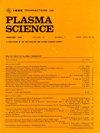微波-等离子体相互作用实验中s磁控管线型脉冲调制器驱动器的设计与开发
IF 1.5
4区 物理与天体物理
Q3 PHYSICS, FLUIDS & PLASMAS
引用次数: 0
摘要
微波等离子体实验系统(SYMPLEs)是我们实验室为研究高功率微波(HPM)与超密等离子体的相互作用而建立的实验系统,等离子体频率$f_{\mathrm { pe}} \gt f_{\mu }$为波频。为这些实验选择的洗涤枪等离子体是脉冲的($100~\mu $ s),并在单发模式下操作。实验活动包括在一个预定的时间范围内,在等离子体参数满足波等离子体相互作用所需的临界条件下,从s磁控管激发和发射脉冲($5~\mu $ s)微波输出到等离子体。因此,磁控管源必须在单次射击模式下工作,并且所有这些射击的HPM输出都是高度重复的。因此,磁控管的脉冲功率驱动器应能够在±5%) single-shot trapezoidal pulses of maximum 52 kV and 120 A current, with $5~\mu \text {s}$ flat top and about 5%–10% rise time, consistent with the requirement of the magnetron. As conventional solid-state modulators pose challenges in achieving shot-to-shot repeatability in single-shot operation, a pulse-forming network (PFN)-based modulator has been chosen despite the stringent pulse rise time requirements. A Guillemin Type-E line-type pulsed modulator has been designed, simulated, and developed indigenously in our laboratory. The design consideration includes the incorporation of a pulse transformer at the output of the pulsed modulator, with the magnetron load impedance of $433.33~\Omega $ constituting the secondary impedance. The primary impedance of $25~\Omega $ is treated as the load impedance for the pulsed modulator. The design approach has involved theoretical estimation of the per-section capacitance, inductance, and coupling coefficient values followed by simulation to determine the best suitable parameters for the 10-stage PFN. A setup consisting mainly of a high-voltage dc charging unit, the 10-stage PFN, a thyratron switch with an appropriate trigger module, and a pulse transformer withbifilar secondary windings has been developed and tested with dummy loads. Experimental results on dummy loads up to 35 kV output give highly reproducible (within ±5%) voltage and current pulses of $5~\mu \text {s}$ flat top and about 300–500 ns rise time. Details of the design, simulation, development, and test results of the line-type pulsed modulator are discussed in this article.本文章由计算机程序翻译,如有差异,请以英文原文为准。
Design and Development of a Line-Type Pulsed Modulator Driver for S-Magnetron for Microwave–Plasma Interaction Experiments in SYMPLE
System for microwave–plasma experiments (SYMPLEs) is an experimental system setup in our laboratory for investigating the interaction of high-power microwave (HPM) with overdense plasma with plasma frequency $f_{\mathrm { pe}} \gt f_{\mu }$ , the wave frequency. The washer-gun plasma chosen for these experiments is pulsed ( $100~\mu $ s) and is operated in single-shot mode. The experimental campaign involves the excitation and launching of a pulsed ( $5~\mu $ s) microwave output from an S-Magnetron to the plasma at a predecided temporal regime where the plasma parameters satisfy the required critical requisites for the wave plasma interaction. Therefore it is necessary that the magnetron source is operated in single-shot mode, and the HPM output of all such shots is highly repetitive. The pulsed power driver for the magnetron should thus be capable of giving out highly reproducible (within ±5%) single-shot trapezoidal pulses of maximum 52 kV and 120 A current, with $5~\mu \text {s}$ flat top and about 5%–10% rise time, consistent with the requirement of the magnetron. As conventional solid-state modulators pose challenges in achieving shot-to-shot repeatability in single-shot operation, a pulse-forming network (PFN)-based modulator has been chosen despite the stringent pulse rise time requirements. A Guillemin Type-E line-type pulsed modulator has been designed, simulated, and developed indigenously in our laboratory. The design consideration includes the incorporation of a pulse transformer at the output of the pulsed modulator, with the magnetron load impedance of $433.33~\Omega $ constituting the secondary impedance. The primary impedance of $25~\Omega $ is treated as the load impedance for the pulsed modulator. The design approach has involved theoretical estimation of the per-section capacitance, inductance, and coupling coefficient values followed by simulation to determine the best suitable parameters for the 10-stage PFN. A setup consisting mainly of a high-voltage dc charging unit, the 10-stage PFN, a thyratron switch with an appropriate trigger module, and a pulse transformer withbifilar secondary windings has been developed and tested with dummy loads. Experimental results on dummy loads up to 35 kV output give highly reproducible (within ±5%) voltage and current pulses of $5~\mu \text {s}$ flat top and about 300–500 ns rise time. Details of the design, simulation, development, and test results of the line-type pulsed modulator are discussed in this article.
求助全文
通过发布文献求助,成功后即可免费获取论文全文。
去求助
来源期刊

IEEE Transactions on Plasma Science
物理-物理:流体与等离子体
CiteScore
3.00
自引率
20.00%
发文量
538
审稿时长
3.8 months
期刊介绍:
The scope covers all aspects of the theory and application of plasma science. It includes the following areas: magnetohydrodynamics; thermionics and plasma diodes; basic plasma phenomena; gaseous electronics; microwave/plasma interaction; electron, ion, and plasma sources; space plasmas; intense electron and ion beams; laser-plasma interactions; plasma diagnostics; plasma chemistry and processing; solid-state plasmas; plasma heating; plasma for controlled fusion research; high energy density plasmas; industrial/commercial applications of plasma physics; plasma waves and instabilities; and high power microwave and submillimeter wave generation.
 求助内容:
求助内容: 应助结果提醒方式:
应助结果提醒方式:


